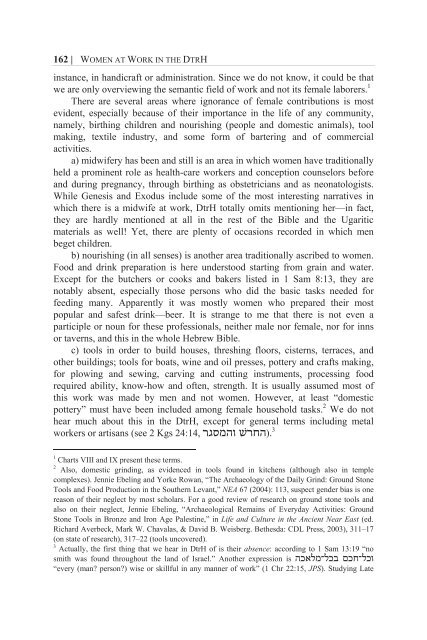Women at Work in the Deuteronomistic History - International Voices ...
Women at Work in the Deuteronomistic History - International Voices ...
Women at Work in the Deuteronomistic History - International Voices ...
You also want an ePaper? Increase the reach of your titles
YUMPU automatically turns print PDFs into web optimized ePapers that Google loves.
162 | WOMEN AT WORK IN THE DTRH<br />
<strong>in</strong>stance, <strong>in</strong> handicraft or adm<strong>in</strong>istr<strong>at</strong>ion. S<strong>in</strong>ce we do not know, it could be th<strong>at</strong><br />
we are only overview<strong>in</strong>g <strong>the</strong> semantic field of work and not its female laborers. 1<br />
There are several areas where ignorance of female contributions is most<br />
evident, especially because of <strong>the</strong>ir importance <strong>in</strong> <strong>the</strong> life of any community,<br />
namely, birth<strong>in</strong>g children and nourish<strong>in</strong>g (people and domestic animals), tool<br />
mak<strong>in</strong>g, textile <strong>in</strong>dustry, and some form of barter<strong>in</strong>g and of commercial<br />
activities.<br />
a) midwifery has been and still is an area <strong>in</strong> which women have traditionally<br />
held a prom<strong>in</strong>ent role as health-care workers and conception counselors before<br />
and dur<strong>in</strong>g pregnancy, through birth<strong>in</strong>g as obstetricians and as neon<strong>at</strong>ologists.<br />
While Genesis and Exodus <strong>in</strong>clude some of <strong>the</strong> most <strong>in</strong>terest<strong>in</strong>g narr<strong>at</strong>ives <strong>in</strong><br />
which <strong>the</strong>re is a midwife <strong>at</strong> work, DtrH totally omits mention<strong>in</strong>g her—<strong>in</strong> fact,<br />
<strong>the</strong>y are hardly mentioned <strong>at</strong> all <strong>in</strong> <strong>the</strong> rest of <strong>the</strong> Bible and <strong>the</strong> Ugaritic<br />
m<strong>at</strong>erials as well! Yet, <strong>the</strong>re are plenty of occasions recorded <strong>in</strong> which men<br />
beget children.<br />
b) nourish<strong>in</strong>g (<strong>in</strong> all senses) is ano<strong>the</strong>r area traditionally ascribed to women.<br />
Food and dr<strong>in</strong>k prepar<strong>at</strong>ion is here understood start<strong>in</strong>g from gra<strong>in</strong> and w<strong>at</strong>er.<br />
Except for <strong>the</strong> butchers or cooks and bakers listed <strong>in</strong> 1 Sam 8:13, <strong>the</strong>y are<br />
notably absent, especially those persons who did <strong>the</strong> basic tasks needed for<br />
feed<strong>in</strong>g many. Apparently it was mostly women who prepared <strong>the</strong>ir most<br />
popular and safest dr<strong>in</strong>k—beer. It is strange to me th<strong>at</strong> <strong>the</strong>re is not even a<br />
participle or noun for <strong>the</strong>se professionals, nei<strong>the</strong>r male nor female, nor for <strong>in</strong>ns<br />
or taverns, and this <strong>in</strong> <strong>the</strong> whole Hebrew Bible.<br />
c) tools <strong>in</strong> order to build houses, thresh<strong>in</strong>g floors, cisterns, terraces, and<br />
o<strong>the</strong>r build<strong>in</strong>gs; tools for bo<strong>at</strong>s, w<strong>in</strong>e and oil presses, pottery and crafts mak<strong>in</strong>g,<br />
for plow<strong>in</strong>g and sew<strong>in</strong>g, carv<strong>in</strong>g and cutt<strong>in</strong>g <strong>in</strong>struments, process<strong>in</strong>g food<br />
required ability, know-how and often, strength. It is usually assumed most of<br />
this work was made by men and not women. However, <strong>at</strong> least “domestic<br />
pottery” must have been <strong>in</strong>cluded among female household tasks. 2 We do not<br />
hear much about this <strong>in</strong> <strong>the</strong> DtrH, except for general terms <strong>in</strong>clud<strong>in</strong>g metal<br />
workers or artisans (see 2 Kgs 24:14, רגסמהו שׁרחה). 3<br />
1 Charts VIII and IX present <strong>the</strong>se terms.<br />
2 Also, domestic gr<strong>in</strong>d<strong>in</strong>g, as evidenced <strong>in</strong> tools found <strong>in</strong> kitchens (although also <strong>in</strong> temple<br />
complexes). Jennie Ebel<strong>in</strong>g and Yorke Rowan, “The Archaeology of <strong>the</strong> Daily Gr<strong>in</strong>d: Ground Stone<br />
Tools and Food Production <strong>in</strong> <strong>the</strong> Sou<strong>the</strong>rn Levant,” NEA 67 (2004): 113, suspect gender bias is one<br />
reason of <strong>the</strong>ir neglect by most scholars. For a good review of research on ground stone tools and<br />
also on <strong>the</strong>ir neglect, Jennie Ebel<strong>in</strong>g, “Archaeological Rema<strong>in</strong>s of Everyday Activities: Ground<br />
Stone Tools <strong>in</strong> Bronze and Iron Age Palest<strong>in</strong>e,” <strong>in</strong> Life and Culture <strong>in</strong> <strong>the</strong> Ancient Near East (ed.<br />
Richard Averbeck, Mark W. Chavalas, & David B. Weisberg. Be<strong>the</strong>sda: CDL Press, 2003), 311–17<br />
(on st<strong>at</strong>e of research), 317–22 (tools uncovered).<br />
3 Actually, <strong>the</strong> first th<strong>in</strong>g th<strong>at</strong> we hear <strong>in</strong> DtrH of is <strong>the</strong>ir absence: accord<strong>in</strong>g to 1 Sam 13:19 “no<br />
smith was found throughout <strong>the</strong> land of Israel.” Ano<strong>the</strong>r expression is הכאלמ־לכב םכח־לכו<br />
“every (man? person?) wise or skillful <strong>in</strong> any manner of work” (1 Chr 22:15, JPS). Study<strong>in</strong>g L<strong>at</strong>e




